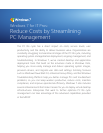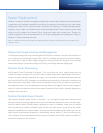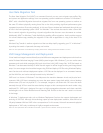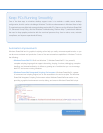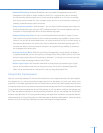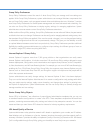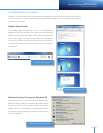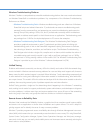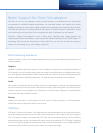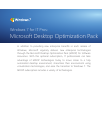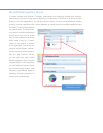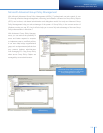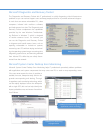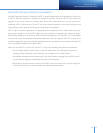
Windows Troubleshooting Platform
Windows 7 delivers a comprehensive, extensible troubleshooting platform that uses a mechanism based
on Windows PowerShell to troubleshoot problems. Key components of the Windows Troubleshooting
Platform are as follows:
• Windows Troubleshooting Packs. Windows troubleshooting packs are collections of Windows
PowerShell scripts and related information. IT professionals can execute troubleshooting packs
remotely from the command line, and enterprises can control troubleshooting pack execution
through Group Policy settings. OEMs, ISVs, and IT professionals can easily author troubleshoot-
ing packs to address needs specic to their infrastructures or applications. Troubleshooting packs
are packaged into .CAB les for simple deployment to PCs across the enterprise.
• Windows Troubleshooting Pack Designer. The Windows Troubleshooting Pack Designer
provides a graphical environment to assist IT professionals and third parties in building rich
troubleshooting packs. It links to the PowerShell Integrated Scripting Environment to facilitate
the authoring of detection, resolution, and verication scripts. The Windows Troubleshooting
Pack Designer also includes a single-click, compile-and-run feature, which enables the author of
a troubleshooting pack to easily compile it, sign it with a certicate, package it into a .CAB le,
and even test it—all by pressing a button in the toolkit’s GUI. The Windows Troubleshooting Pack
Designer is provided as part of the Windows 7 software development kit (SDK).
Unied Tracing
Problems with network connectivity can be very difcult to identify and resolve. While the network diag-
nostics included in Windows can resolve many problems for users and help avoid support calls, there are
always cases for which assisted support is required. Before Windows 7, each networking component had
its own method for tracing and collecting the information needed for troubleshooting, often with differ-
ent output formats. This made it difcult to collect and analyze all of the information needed to solve the
problem, often requiring several cycles of problem reproduction and data collection.
Unied Tracing provides a single tool for determining what’s happening in the Windows 7 networking
stack, making it much easier for support professionals, system administrators, and developers to diagnose
and solve problems. It collects event logs and captures packets from across all layers of the networking
stack using only in-box tools, and groups the data into activities on individual components.
Remote Access to Reliability Data
Windows Vista introduced the Reliability Monitor, a graphical tool that correlates overall system stability
and events such as application or device driver installations and system failures. This tool is helpful in
guiding support staff to identify the cause of many common problems.
Windows 7 provides programmatic access to reliability data through Windows Management Instrumen-
tation (WMI), which means that you can remotely access that data for one or many PCs using PowerShell,
System Center Conguration Manager, System Center Operations Manager, and third-party manage-
ment tools. In this way, you can easily check stability status and view recent events remotely, reducing the
time it takes to solve problems.



